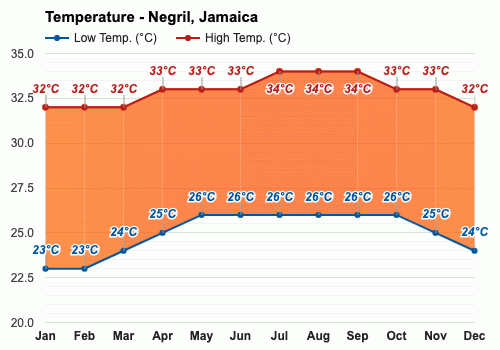Contents
- The climate of Negril
- The best time to visit Negril
- Weather in February
- Weather in March
- Weather in April
- Weather in May
- Weather in June
- Weather in July
- Weather in August
- Weather in September
- Weather in October
- Weather in November
- Weather in December
- Frequently asked questions
- Average temperature
- Average rainfall
- Average rainfall days
- Average sea temperature
- Average daylight
- Average sunshine
- Average UV index

The climate of Negril
In the realm of temperature, Negril braves a stable range with highs varying from 32°C (89.6°F) to 34°C (93.2°F) and lows wavering from 23°C (73.4°F) to 26°C (78.8°F) annually. Throughout the year, the region sees a spectrum of sea temperatures commencing at 26.9°C (80.4°F) and peaking at 29.8°C (85.6°F), boasting a balmy aquatic environment. Regarding sunshine, the town enjoys a steady 6 to 8 hours daily. A consistent UV index fluctuating from 8 to 12 throughout the year demands careful sun protection planning.
Negril receives considerable rainfall, with the driest month (February) recording 58mm (2.28") and the wettest (October) peak at 301mm (11.85"). This substantial precipitation punctuates the year with rainfall days garnering double digits from May to October. Such consistent rainfall ensures a verdant landscape dotting this tropical region.
The best time to visit Negril
Weather in February
Weather in March
Weather in April
Weather in May
Weather in June
Weather in July
Weather in August
Weather in September
Weather in October
Weather in November
Weather in December
Frequently asked questions
What month is the coldest in Negril?
What is the driest month in Negril?
How many days does it rain in Negril?
What are the months with the coldest sea water in Negril?
What are the months with the lowest UV index in Negril?
What are the months with the most sunshine in Negril?
What is the month with the highest UV index in Negril?
When are the longest days in Negril?
What month is the hottest in Negril?
When is the sea warmest in Negril?
What is the rainiest month in Negril?
What is the month with the least sunshine in Negril?
What is the month with the shortest days in Negril?
Is there Daylight Saving Time (DST) in Negril?
Average temperature
Negril, Jamaica

The warmest months (with the highest average high temperature) are July, August and September (34°C).
The months with the lowest average high temperature are January, February, March and December (32°C).
The months with the highest average low temperature are May, June, July, August, September and October (26°C).
The coldest months (with the lowest average low temperature) are January and February (23°C).
Average rainfall
Negril, Jamaica

- Average rainfall in January:
58mm - Average rainfall in February:
61mm - Average rainfall in March:
95mm - Average rainfall in April:
142mm - Average rainfall in May:
271mm - Average rainfall in June:
223mm
- Average rainfall in July:
205mm - Average rainfall in August:
217mm - Average rainfall in September:
229mm - Average rainfall in October:
301mm - Average rainfall in November:
107mm - Average rainfall in December:
64mm
The wettest month (with the highest rainfall) is October (301mm).
The driest month (with the least rainfall) is January (58mm).
Average rainfall days
Negril, Jamaica

- Average rainfall days in January:
8 days - Average rainfall days in February:
6 days - Average rainfall days in March:
6 days - Average rainfall days in April:
7 days - Average rainfall days in May:
11 days - Average rainfall days in June:
13 days
- Average rainfall days in July:
13 days - Average rainfall days in August:
13 days - Average rainfall days in September:
14 days - Average rainfall days in October:
16 days - Average rainfall days in November:
11 days - Average rainfall days in December:
9 days
The month with the highest number of rainy days is October (16 days).
The months with the least rainy days are February and March (6 days).
Average sea temperature
Negril, Jamaica

The best months for swimming (with the highest average sea temperature) are August and September (29.8°C).
The coldest months (with the lowest average sea temperature) are January and February (26.9°C).
Average daylight / Average sunshine
Negril, Jamaica

- Average daylight in January:
11h and 1min - Average daylight in February:
11h and 4min - Average daylight in March:
12h and 1min - Average daylight in April:
12h and 4min - Average daylight in May:
13h and 0min - Average daylight in June:
13h and 1min
- Average daylight in July:
13h and 1min - Average daylight in August:
12h and 4min - Average daylight in September:
12h and 1min - Average daylight in October:
11h and 4min - Average daylight in November:
11h and 2min - Average daylight in December:
11h and 1min
The month with the longest days is June (Average daylight: 13h and 12min).
The month with the shortest days is December (Average daylight: 11h and 6min).
The months with the most sunshine are February, March, April, July and August (Average sunshine: 8h).
The month with the least sunshine is October (Average sunshine: 6h).
Average UV index
Negril, Jamaica

The months with the highest UV index are March, April, May, June, July, August and September (UV index 12).
The months with the lowest UV index are January and December (UV index 8).
Negril, Jamaica
Weather forecast for your location
2. Allow the app to use your location


